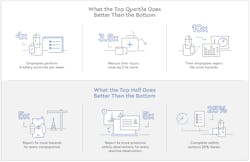As huge safety nerds, we’re obsessed with discovering what the safest companies in the world are doing right, and why other companies struggle.
In the first safety study of its kind, we used machine-learning algorithms to analyze 250 million data points across our client base over a three-year period to learn what the safest cultures have in common. We started with no theory to prove or ax to grind.
Our data showed that the top quartile and top half of safety performers had very distinct safety behaviors, compared to the bottom quartile and bottom half. Not surprising in the least (see Figure 1).
However, what is fascinating is that we can now quantify and benchmark leading indicators of safety performance that are proven to actually work. No more theories, books, or gimmicks. The proven recipe for better safety performance is deceptively simple, measurable and within reach for organizations of all sizes.
We supplemented our fact-driven approach with interviews to understand the “why” and the “how” behind the significant improvement in safety performance. We learned some creative tactics to make this happen too, which can be read here.
The companies we studied saw a 55% reduction in incident rates on average across the pool, with top quartile firms averaging a 72% reduction.
How did they get there?
WHAT DOES GREAT LOOK LIKE?
Think of a great athlete you admire and recount a milestone like their points average, goals per season, touchdowns, etc. This is what great looks like for their sport. This is their life’s major professional accomplishment.
Now, switch gears… what does this look like for safety performance in your industry? What does great look like? If you’re struggling, or if the picture looks a little fuzzy, you’re not alone. Of course, there are many safe companies, well-deserved safety awards handed out, and insurance statistics if you want to benchmark your average injury rates.
The problem is that these awards and benchmarks are not very helpful for most organizations in making a direct link between what great looks like and how to get there. Organizations are in different industries, face different hazards, and are at different phases of safety maturity. So what is a better way?
First, we needed to take a stand on how to measure success. We argue it is the percentage reduction in the injury rate in the organization over 2-3 years. Or, the amount of time it takes for most organizations of any size to take action and see the fruits of their labor show up in that lagging indicator.
Each organization may have a different starting point, changes in staff levels, or context. But we’re all trying to get better so the change in your injury rate over time seemed to be the simplest widely-reported statistic.
HOW TO GET THERE
How does the star athlete you thought of earn their success? A combination of natural talent, hard work, the right coach, the right teammates? The secret sauce is often discussed by ESPN TV hosts and we often repeat it to our children competing in any sport. We remind them that any natural talent is never enough to take it to the next level.
In safety, we have our secret sauce too and now that it’s proven out, it’s nice to know that making that next 50% reduction in your injury rate is NOT as difficult as becoming a star athlete.
Researching companies in hazardous industries such as construction, energy, utilities, infrastructure services and manufacturing showed us that front-line participation is the secret sauce of organizations that improve safety performance by over 50%.
STATISTICALLY, WHAT DO THE SAFEST ORGANIZATIONS HAVE IN COMMON?
Based on our statistical analysis of our clients’ safety activities, we discovered that the top safety performers had:
Participation of Four Activities Per Week
Front-line supervisory staff had at least four safety activities per week or nearly one per day. These proactive or scheduled activities include safety observations, hazard assessments, hazard IDs, toolbox talks, tailboards, corrective actions, etc.
In our study, all customers were enabled with our eCompliance mobile app. Call this a bias if you may as we did not have a control group conducting activities on paper/Excel spreadsheets, but we have seen customers on average double the safety activities per person vs. what was tracked before.
Visibility on 10x More Hazard Recognition
This high level of activity on the front-lines did two things:
1) Create 10x the recognition or assessment of hazards than bottom quartile companies.
2) Create a new level of data velocity and transparency in the company on opportunities to create a lower risk environment.
A real-time dashboard of all the activities above was almost always a first-time occurrence in these companies, despite some already sophisticated safety programs amongst the sample group.
Safety Reflex Times 25% Faster
For example, the speed of getting front-line supervisor feedback to the VP of Operations on a reoccurring theme in one company went from four months on average to something that was reviewed in weekly meetings with regional managers and the Safety Director.
This allowed the organization to reflex effectively and take action decisively based on the facts. This also satisfies the increasing appetite from executives for a data-driven and predictable reporting environment that can put pressure on EHS teams that have not invested in the systems to effectively respond.
On average, speed on closing out formal corrective/preventative actions was 25% higher in top quartile performers but the total rate of action item generation was several magnitudes greater.
CULTURALLY, WHAT DO THE SAFEST ORGANIZATIONS HAVE IN COMMON?
To enable the above, from our interviews, we determined these organizations also had:
Leadership from the Top
A CEO, President or Owner that spoke up about safety and empowered the VP or Director of EHS/Safety.
Usually, CEOs fell into two camps:
1) They have experienced the impact of a workplace injury to themselves or a close colleague in the past, and/or
2) They recognize an opportunity to differentiate their company and brand in the face of their end customers through great safety performance.
A Safe Operations Mindset
A VP or Director of EHS/Safety that was empowered by the CEO above to actively engage operational leaders and collaborate to view safe operations as inextricably linked, rather than safety as another siloed support function in the company.
This appears to be the nuanced recognition that while safety needs to be invested in and have someone with a “seat at the table” in senior leadership team meetings, it is every operational executive’s responsibility to work together to reduce risk and increase the productivity of the workforce.
One thing may be up for debate: Is front-line participation and the development of the safety reflex the underlying cause of OR a by-product of great leadership?
Either way, organizations did NOT prove these huge leaps in safety performance without this secret sauce. Therefore, it’s a no-brainer to start measuring and building your organization’s own benchmarks around these and at least experiment with them.
Some other fascinating stats are shared in Figure 1 above. Overall, empowering the front-lines to participate easily with simple “safety use-cases,” and allowing the organization to develop the reflexes to respond and make efficient use of this valuable data helps build a safe operations culture (or vice versa).
Either way, there is some low hanging fruit we can easily act on.
WHERE DOES YOUR SAFETY CULTURE COMPARE?
Our study data has 80-85% statistical accuracy, so to the skeptics out there I would say, “Is your organization so fundamentally different from our study group that the above changes would somehow make safety performance worse?”
If the answer is “probably not” then you probably have nothing to lose. This is the opportunity to make a real impact on your colleagues’ lives and propel your career as a result of your impact.
We “safety nerds” are proud to harness the power of Big Data and illuminate new findings that advance our collective goal: to eliminate workplace injuries and make our work environments safe to work in for our family, friends and future generations.
About the Author
Adrian Bartha
CEO
Adrian Bartha is CEO of eCompliance (www.ecompliance.com), a provider of EHS software solutions. He formed eCompliance with his business partner in 2012 after experiencing firsthand how a workplace incident affected a power company that he helped lead. Combining his background in finance with his knowledge of health and safety, he now educates safety professionals on how to demonstrate a return on safety.

